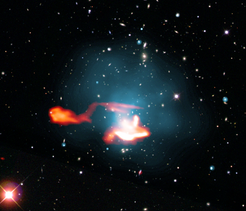LOFAR radio observations document rejuvenation in space
In observations of galaxy clusters, astronomers in collaboration with the MPA discovered a new class of cosmic radio sources. With the digital radio telescope Low Frequency Array (LOFAR) they received the longest radio waves that can be measured on Earth. They identified a remarkable "tail"behind a galaxy in the radio light, which must have been re-energized after it had faded away. In the journal Science Advances, the team describes this discovery, which either confirms a theoretical prediction on the interaction between shock waves and radio plasma or represents a novel phenomenon.

Looking into space with the help of radio telescopes, astronomers often find long, radio-luminescent tails behind wandering galaxies. These tails occur when the active black hole in the center of a galaxy produces clouds of energetic electrons with typical velocities close to the speed of light. These clouds then stay behind the galaxy, which is traveling through the gas filling the intergalactic space.
Normally, these luminous trails fade over time until they are not visible anymore, as the electrons radiate their energy away. However, a group of researchers from Germany, Italy, the Netherlands and the United States observed the galaxy cluster Abell 1033 at very low radio frequencies and found that one of the tails was behaving contrary to expectations, starting to glow again in the galaxy gas (see figure).
This is surprising as the electron clouds that make up the tail gradually release their energy. They should therefore fade until they finally disappear completely. Instead, in this case, the observed tail still shines after more than a hundred million years - and what is more, it is located in the middle of a cluster in which several galaxies are merging.
For Dr. Torsten Enßlin at the MPA, however, this was not a surprise, but rather the confirmation of his prediction. In 2001, in cooperation with Indian scientist Gopal Krishna (IUCAA), he postulated a connection between gas dynamics in galaxy clusters and a rejuvenation of radio plasma. When radio plasma is compressed via shock waves, electrons gain energy adiabatically, just like molecules in a bicycle pump get heated via compression. If enough energy was transferred, the electrons become visible again in the frequency range of radio telescopes. It is important to note that compression has to happen fast enough so that it outperforms the simultaneous loss of energy via radiation, which makes the electrons invisible again. The recent discovery of a re-illuminated radio tail may therefore confirm the theory of Enßlin and Krishna. Torsten Enßlin was responsible for the theoretical interpretation of the observational data in the current project.
Nevertheless, the structures observed in Abell 1033 and their origin remain mysterious. The tail has gigantic dimensions and should be "dead" in the astrophysical sense, because only then can a radio tail rise from the ashes like a phoenix if a shock wave squeezes the gas over a long distance simultanously. The angle between tail and shock wave needs to be adjusted exactly, otherwise only a small region would light up. Either this special geometry is just a coincidence in this case, which could also explain why this phenomenon occurs so rarely in this size; or a completely different, as yet unknown, mechanism must be responsible for the rejuvenation.
The new discovery was made possible by a cooperation between the Indian Giant Meterwave Radio Telescope (GMRT) and the European Low Frequency Array (LOFAR). LOFAR is able to detect radio waves with a length of up to 30 meters. The unique telescope connects thousands of antennas located in eight different countries, their data converge in a supercomputer in Groningen (Netherlands). The computer collects 200 gigabytes of data per second and thus forms a virtual radio telescope, which is just as large as the European continent and can therefore pick up very long-wave and weak radio signals. MPA operates a LOFAR station in Unterweilenbach near Munich.












